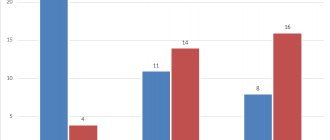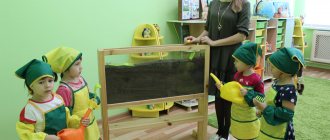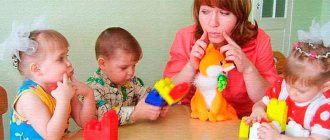Article:
Delayed psychospeech development in children (DSRD) is a disruption of the normal pace of mental development of a child.
The pathology includes a complex of disorders of speech, thinking, memory, attention, emotions, normal behavioral skills, and motor functions. Children experience frequent, causeless mood swings. All disorders of psycho-emotional development manifest themselves to the same extent, none of them is predominant. The child has difficulty learning new skills, cannot think abstractly, speak, perform simple logical actions, or use existing knowledge and skills in everyday life. Children's imagination and memory suffer, and their attention becomes distracted.
If children are diagnosed with speech development delay (SDD), all basic mental functions, except speech, remain intact. The main sign of delayed speech development is a discrepancy between the level of speech and age standards. Speech skills lag behind the norm for several age periods, although mental activity, intelligence and emotions are normal. The child understands spoken speech, reacts adequately to it, follows 1-2-step instructions, but speaks little and reluctantly, not using speech as a tool of communication. Without corrective actions, the child, having matured, becomes uncommunicative and non-contact.
Causes of PVD in children
Disruption of the speech and motor areas of the brain leads to disorders of speech, intellectual abilities, and motor functions. A child may develop PVD for the following reasons:
- Increased intracranial pressure, which may be a consequence of improperly performed vaccinations or previous infectious diseases.
- Birth trauma, long anhydrous period, fetal hypoxia.
- Genetic predisposition.
- Stopping breastfeeding too early.
- Social factors, lack of speech practice in the family during the period of formation of the baby’s speech zones of the brain.
- Diseases of the gastrointestinal tract, hearing, allergies, inflammation of the adenoids, otitis media, traumatic brain injury suffered in early childhood.
- Structural anomalies or damage to the cervical spine during childbirth or cesarean section.
Delayed psychospeech development in children may be suspected if the following symptoms are noted:
- has difficulty completing basic tasks following verbal instructions without the use of visual assistance or gestures;
- the child’s speech development does not correspond to age standards;
- cannot concentrate during play activities, reading books to him, watching cartoons, listening to children's songs and poems;
- poor vocabulary, he misunderstands the meaning of simple words;
- cannot play games appropriate for his age with peers.
Particular attention should be paid to the situation when a child refuses to communicate with peers, older children and adults. Possible causes of these disorders are autistic manifestations or mental development disorders.
If you do not pay attention to mental retardation in time, then over time, by the age of 5–6 years, the disease will develop into a general underdevelopment of speech, which is more difficult to correct.
FEATURES OF DIAGNOSTICS OF CHILDREN WITH DID
One of the main psychological and pedagogical problems is the diagnosis of children with learning difficulties.
Children with mental retardation who come to school begin to experience learning difficulties. They lack the development of certain mental functions, abilities, and skills; they do not keep up with other students, because they lack the knowledge to master the material taught in secondary schools. Such children will not be able to master general school material without special help.
A child with mental retardation can be distinguished from ordinary children by certain features.
1. Children with such deviations in mental development get tired very quickly, cannot absorb a given amount of work, and their level of performance is reduced.
2. Children with mental retardation have difficulty accepting and processing (analyzing) information that comes from the teacher. For a more complete perception, he needs to rely on visual aids. Difficulties also arise during mental activity, because verbal and logical thinking is undeveloped.
3. Children in this category experience difficulties with generally accepted forms of behavior at school. They often become bullying, fight with peers, and do not accept school rules. Role-playing games are not available to children with mental retardation, but in order to get away from difficult tasks, they can happily play simpler games.
4. Children with mental retardation have difficulty organizing their activities. 5. Studying according to the general education school program is unacceptable for them, because their mental development is at an earlier level. Therefore, the teacher needs to observe such children for correct differentiation, and be very patient so as not to send children with normal development to a special class.
In children with mental retardation, mental underdevelopment is clearly expressed in decreased learning ability. But if such children are provided with special correctional and pedagogical assistance in a timely manner, they will be able to catch up with their normally developing peers.
Scientists agree that diagnostics should be carried out in a psychological and pedagogical aspect. Not all children in this category have a pronounced neurological status, but at the same time there are some signs reminiscent of mild debility. However, neurological symptoms of a residual nature cannot be the main one in the diagnosis of mental retardation, because it may be similar to symptoms in normally developing children with certain diseases. In this case, it is better to carry out diagnostics in psychological and pedagogical terms. When diagnosing mental retardation, you need to pay attention to how the child completes the task independently and how he manages to do it with the help of an adult. Children in this category cope with a task with the assistance of a teacher much faster and more efficiently; this distinguishes them from mentally retarded children, and attention should be paid to this fact when diagnosing.
If the main symptom is a lack of memory, attention, transition and speed of mental processes, then a diagnosis of mental retardation is made (T.V. Egorova).
But some children can be definitively diagnosed only after psychological and pedagogical observation during their studies in the lower grades of secondary school.
Also, one of the diagnostic stages includes a significantly low level of gaming activity (in contrast to peers). They are unable to play role-playing games, they are unable to choose a topic without adult intervention, and in role-playing games they cannot assign roles. Difficulties also arise with compliance with the game plan (scenario).
But if we compare children with mental retardation with mentally retarded children, we will see that children with mental retardation are always adequate in their actions and play with any toy in accordance with its purpose.
Diagnosis and examination
Diagnosis of speech development delay is carried out by the following specialists:
- A neurologist will help you cope with diseases of the nervous system that underlie the defect.
- The pediatrician diagnoses and treats physical illnesses that could be contributing to the speech delay.
- A defectologist works with children on speech correction and the development of higher mental functions starting from the age of three. Classes are aimed at developing speech, thinking, memory, attention, fine and gross motor skills.
- A speech therapist will help stimulate speech development, master correct speech breathing, articulation of sounds, teach you how to control your speech, formulate thoughts and statements, and master vocabulary and grammatical forms. Classes can begin from 3–3.5 years.
- An educational psychologist establishes a diagnosis of mental retardation in children of primary school age or preschoolers based on special tests.
A neurologist may prescribe MRI, electroencephalography, computed tomography, neurosonography to exclude a lesion in the brain.
You can independently conduct a primary diagnosis of speech problems in a 3.5–4.5 year old child by observing him and conducting simple tests:
- To find out whether the child understands the meaning of words, you can say the names of objects in the immediate environment without looking at them, and offer to show them.
- To determine the understanding of the meanings of adjectives, you need to show two identical objects of different colors and ask: “Where is the red (ball)? Where's the blue one?
- To find out whether the baby understands verbs, you can show 2-3 pictures where the same character performs different actions, ask: “Where (the bird) flies, pecks, sits?”
- To determine the understanding of the meanings of prepositions, invite the child to put a toy or pencil on the box, in the box, behind the box, in front of the box, under the box.
- To find out whether the child uses grammatical categories correctly, he is asked to name the word in the plural (this is a hand, and this is... hands), create a diminutive form of a noun (the giant has legs, and the gnome has... legs), change the verb according to gender (the dog ran away, and the dog... ran away).
- To determine the state of phrasal speech, suggest finishing the started sentence about the object depicted in the picture (the girl... bought bread in the store, the boy... is riding home on a bicycle).
- To determine the ability to preserve the picture of a word, they are asked to repeat after an adult words consisting of 3-4 syllables: samovar, hammer, policeman, excavator, dandelion, ran across, etc.
Non-drug treatment
A necessary condition for the success of treatment is the inclusion of non-drug methods, which include:
- classes with a speech therapist;
- massage;
- exercise therapy;
- sessions with a psychologist;
- short-term sessions of individual psychotherapy for 1 hour 2 times a week after 3, 6, 12 months;
- dolphin therapy;
- occupational therapy;
- hippotherapy;
- acupuncture;
- magnetotherapy.
For treatment to be effective, a trusting relationship, mutual understanding and proper contact should be established between the child and the specialist. You can use family and behavioral psychotherapy.
The following exercises and tasks are used to develop speech:
- Teach your child to talk about the image in the picture. There is no need to change pictures often. It is advisable to gradually increase your vocabulary by describing the same picture.
- It is emotional to tell a child a story, making him want to imitate you.
- Read a short, interesting story and ask to retell it.
- Learn poems, nursery rhymes, and songs together.
- Communicate with the baby as much as possible, while trying not to understand his gestures, but insist on pronouncing sounds, syllables and words.
- Show the child the images, ask them to arrange them sequentially and make up a story.
- Constantly enrich your child’s vocabulary.
- Learn to speak in a monologue, and in the future - maintain a dialogue.
- Try together to describe, compare, teach to generalize events and natural phenomena.
One of the most basic conditions for achieving success is that a child should be interested in playing and learning. During joint classes, the atmosphere should be friendly.
Children with mental retardation have difficulty maintaining attention, quickly lose interest in a task, get distracted, and often cannot complete the game. This affects speech development, so you need to show tact and patience. The duration of classes should increase gradually.
Several exercises for home exercises to correct mental retardation:
- Guess who. Hide toys or pictures of animals and invite them to look for them, while imitating their voices.
- Guess the toy. Scatter toys around the room, offer to find one of them, naming only its signs.
- Parts of the whole. Show a picture or toy, naming parts of the object (nose, eyes, ears, head, neck, arms, legs, torso, tail), ask to repeat after the adult.
- Which? Consider five familiar toys or household items. Guess and take them out of a box or bag, then invite the baby to describe them, naming the color, shape, surface, taste, etc.
- Call me kindly. Show a picture of a large object and offer to name the same small object affectionately.
- What is missing. Show pictures that show objects with missing parts (a ball without a thread, a flower without a stem, a flag without a stick).
- What didn't happen? Show first three toys, then more, invite the baby to close his eyes, remove one and then name the one that disappeared, remember where it was, return it to its place, then switch roles.
Scheme of examination of a child with mental retardation
Personal data
Last name, first name of the child__________________________________________________________
Date of Birth __________________________________________________________
Home address_________________________________________________________
Which d/s did you come from__________________________________________________________
(no. d/s, district)
Date of admission to the group ________________________________________________
Decision of the medical-pedagogical commission dated_________________________________
Protocol No. ___________________ adopted for the period ___________________________
Conclusion of the medical-pedagogical commission
______________________________________________________________________
______________________________________________________________________
Date of filling out the card______________________________________________________________
Defectologist ____________________________________________________________
By the decision of the RMPC dated _____________________________________________________
issued with __________________________________________________________
V____________________________________________________________________
(type of school, d/s)
Members of the RMPC_________________________________________________________________
(names of speech therapists, place of work)
Anamnesis
Information about parents__________________________________________________________
Hereditary diseases _____________________________________________________
What pregnancy is the baby from?__________________________________________
Nature of pregnancy (falls, injuries, psychoses, infections, chronic diseases)__________________
Childbirth (urgent, early, rapid, dehydrated, prolonged)______ Stimulation (mechanical, chemical, electrical stimulation)_______________
When the child screamed _________________________________________________
Was asphyxia observed (blue, white)_________________________________
Rh factor (negative, positive) _______________________________________
Weight and height of the child at birth__________________________________________
Feeding (when they brought you to feed, how you took the breast, how you sucked, whether you burped, choking)______________
Discharged from the maternity hospital on ____day (reasons for delay)
Early psychomotor development
(check if there were any deviations from the norm)_____________________________________________
Past illnesses
(bruises, head injuries, infections, convulsions at high temperatures - before a year, after a year)
________________________________________________________________
Speech anamnesis
First words _____________________________________________________
(From what age)
First phrases__________________________________________________________
(From what age)
Was speech development interrupted?__________________________________________
Neurological status _____________________________________________________
Data from psychological and pedagogical examination
I. General information
1. Is it easy to come into contact during examination ________________________
2. The child’s idea of himself and his immediate environment ___________________
(accuracy of representations)
II. Characteristics of intellectual activity
Features of perception:
1. Perception of an object, a picture (recognition of an object in a schematic, intersecting image) ________________
2. Identification of essential details, parts of the subject __________________
3. Ability to complete drawing of an object_______________________________________________
4. Perception of size_______________________________________________
5. Color perception:
a) does the color correspond to_________________________________________________
(using silent instructions, check)
b) does he distinguish colors?________________________________________________
c) distinguishes and knows the names of colors_________________________________
6. Shape perception:
a) knows, differentiates basic geometric figures _______________
b) recognizes the shapes in a drawing, in an object (task: “Help mother and daughter hang colored handkerchiefs”, etc.)______
7. Perception of space:
a) distinguishes between the right and left sides on his body, on the body of another person___
b) can fold a cut object picture (vertically, horizontally, diagonally)_________________
c) navigates in space_____________________________________________
d) understanding of prepositions (simple, complex)________________________________
8. Perception of time (parts of the day, seasons)__________________________
Level of voluntary attention, sensorimotor coordination, fine history skills
1. Draw the picture “House”:__________________________________________
2. The ability to visually plan the completion of a task (“Labyrinth”, “Guide the bunny to the carrot”)______________
Memory Features
1. Speed of memorization, accuracy of reproduction (remember and reproduce 10 words in any order 1-5 times, then after 50-60 minutes; the norm is reproduction of 3-4 words in an hour). ____________
2. Memorizing a short poem__________________________________________
Features of thinking
1. Non-verbal classification of geometric shapes: does he understand non-verbal instructions when laying out geometric shapes according to a certain characteristic (color, shape) ______________________ (24-26 cards with images of geometric shapes are used)
2. Ability to generalize (based on the picture) ________________________________
including by purpose (what you can wear, eat)______________________
Selection of a generalizing word _____________________________________________________
3. Classification of general concepts (dishes, clothing) ___________________
4. Elimination of an extra item (4th extra) ____________________________
5. Understanding a series of pictures connected by a single plot __________________
6. Coming up with the beginning and end of a story based on a series of pictures________________
7. Can ____________________________________ explain the meaning of the riddle?
9. Does it establish cause-and-effect relationships______________________________
10. Ability to abstract_____________________________________________
Features of speech
1. Understanding verbal instructions (regulatory function of speech)_______________
2. Volume of passive vocabulary _____________________________________________
(by subject, plot pictures)
3. Volume of the active dictionary_______________________________________________
(by subject, plot pictures)
4. Features of phrasal speech _____________________________________________________
(by subject, plot pictures)
5. Connected speech:
a) compose a story based on a short picture ___________________________________
b) make up a story based on a series of pictures_____________________________________________
c) retelling a short text_______________________________________________
Development of elementary mathematical concepts
1. Counting items up to 5-10 __________________________________________
2. Correlating a given number of objects with the number of fingers __________________
3. Identification of objects from a set (1-5) by word, pattern, display_________
4. Comparison of sets_________________________________________________
(more, less, equal)
5. Accounting operations:
-: on specific material - counting out loud_________________________________
- on specific material - counting “to yourself”___________________________
— abstractly (without specific material)________________________________
6. Solving simple problems (6 years)
— on a specific material _____________________________________________________
- abstractly______________________________________________________________
7. Coming up with simple problems (6 years)
— on a specific material _____________________________________________________
- abstractly ______________________________________________________________
Constructive activity
1. Ability to build according to the model___________________________________________
2. Ability to build according to a graphic drawing______________________________
3. Ability to build independently________________________________________________
4. The ability to sketch and play with a building_________________________________
Features of the emotional-volitional sphere
1. The child’s emotional reaction to the examination itself _________________
2. Nature of activity:
a) showing interest in the task, persistence of interest______________________
b) purposefulness of activity__________________________________________
c) the presence of self-control in activities________________________________________________
(needs help, to what extent)
3. The ability to transfer the shown method of activity to similar tasks __________________
4. Criticality in assessing one’s activities______________________________
5. Understanding the emotional meaning of pictures and texts _____________________
6. Emotional stability (instability) of behavior________________
7. Contact in communication with adults, children __________________________
Consultations of specialists_________________________________________________
Conclusion of a defectologist based on the results of the examination ________________________________________
Ways to prevent the disorder
By influencing the causes of speech delay, it is possible to effectively carry out prevention, treatment and reduce morbidity.
The main preventive measures include:
- adherence to sleep and wakefulness;
- joint holding of family holidays and events where children are given due attention;
- early start of classes with a speech therapist individually or in special correctional groups;
- reading children's literature, studying children's poems together, walks, trips;
- a balanced diet that excludes or reduces bread, cookies, eggs, milk, honey, candy, potatoes, beets, crackers, chicken, shrimp, chocolate, exotic fruits and berries from the baby’s diet;
- psychotherapy in a group.
An indicator of the effectiveness of treatment is the compliance of speech and mental development with the age norm.
Advice for patient and attentive parents on what to do for children with mental retardation:
- Carry out regular medical examinations with the involvement of a neurologist, pediatrician, speech therapist, otolaryngologist, orthopedist, and ophthalmologist.
- Develop the child’s understanding of speech using simple instructions such as “give me a book”, “take a cup from the table and take water to grandma.”
- You need to read, sing, talk with your baby, voicing all your actions and surrounding events and try to provoke him into dialogue.
- Without waiting for the child to speak, it is necessary to develop the baby’s sensory skills, teach him to distinguish objects by size, shape, color, and develop fine motor skills of the hand.
How to test hearing in children with suspected autism
It is worth saying that testing hearing in children with disorders of psycho-speech development is not so simple. Among the methods that can reliably demonstrate the result, you can find several procedures that allow you to assess the hearing status of a small patient.
The first method is threshold pure audiometry . The child is wearing headphones and when a beep sounds, he must press a button on the remote control. It should be noted that even for children with no deviations, this cannot always be done correctly. For autistic people, this is an almost impossible procedure. It is almost impossible to seat such a child in a chair, much less force him to follow instructions, so we do not use this technique.
The second method is SEP (short-latency auditory evoked potentials) . Quite painstaking work for a doctor who examines a child with disabilities. The procedure is carried out in a state of sleep, and the activity of the nervous structures of the auditory analyzer in response to the supplied sound is recorded.
Unfortunately, in many cases this is not possible with a child suspected of having autism. Such children do not allow themselves to be examined, much less have sensors attached to their heads.
The third method is registration of otoacoustic emissions (OAE) , which can be useful for diagnosing hearing in children with impaired psycho-speech development and autism. A special sensor is placed in the patient’s ear for several tens of seconds and if there is a response signal, the doctor can assume that there is a hearing impairment or the absence of pathologies.
However, everything is so easy at first glance. Children with suspected autism are in no hurry to allow themselves to be examined and try in every possible way to escape from the hands of their parents and doctor. The moment when you manage to insert the sensor into your ear can be considered a great success. If you are lucky and the child miraculously falls asleep, then the procedure can be carried out successfully. Otherwise, only cartoons, a phone in your hands, or distracting maneuvers will help.
The best option in this case would be to call a doctor at home. Our Extend clinic has high-precision equipment that will reduce the stress of hearing testing for the child and parents. The whole procedure takes place in a child-friendly environment at his home and does not take much time.
The most common mistakes parents make that lead to problems
Parents must have unconditional emotional acceptance of the child, despite the characteristics of children with mental retardation. When the needs for safety, love and care are met, emotional closeness with family members arises. Against this background, there is a desire to be in the company of other people and create warm and trusting relationships. It is necessary to pay attention not only to health and nutrition, but also to mood, needs, and contact with the baby.
You shouldn't wait until four or five years old to see a speech therapist for sounds. Correcting speech delays needs to be addressed at an earlier age, and is done somewhat differently than correcting incorrect pronunciation. The absence of corrective measures will lead to the fact that speech delay will develop into general speech underdevelopment, which entails a lag in the child’s development and a stable decline in intelligence.
Some parents do not want to go to these classes, not realizing that not only classes with a speech therapist and drug treatment, but also correctional programs and a well-structured psychotherapeutic environment will help solve/cure the problem.
Children with mental retardation require treatment, which begins with the introduction of correct guidelines into the communication strategy of their parents. Incorrect parental behavior in such cases worsens the already unfavorable environment for the child’s development. We must remember that the social and age-related crises of the family should not affect the child. The baby is drawn to adults and will be more intellectually similar to the parent with whom he communicates more intensely and whom he imitates.




